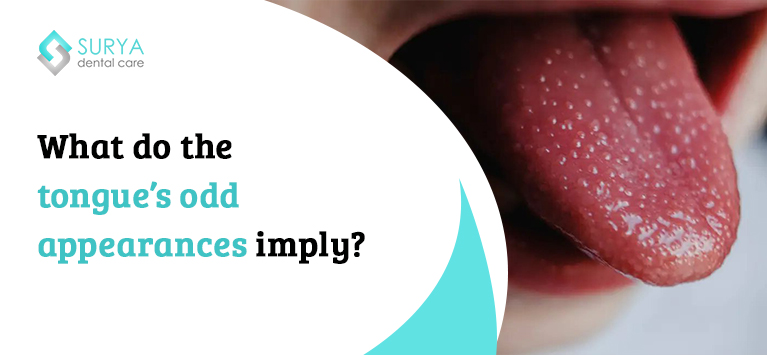
Tongue is a small muscular organ that contains thousands of taste buds. Besides licking and tasting, the tongue plays a vital role in breathing, swallowing, sound & speech formation. A healthy tongue is supposed to have a pink color (the shade varies light or dark for some people) with a thin whitish coating having tiny grooves over the surface. Such grooves are called papillae where taste buds are present.
The discolored patches on tongues are harmless and are usually caused by not cleansing the tongue. However, factors like aging, stress, and medications have an impact on the tongue’s appearance. Similarly, various systemic diseases contribute to the tongue varying in color and appearing in unusual ways.
If you are interested in figuring out those underlying conditions? This blog article is for you. Keep reading.
1) White-colored tongue
The creamy white-colored patches on the tongue are caused by a bacterial imbalance in the mouth occurring due to bacteria, germs, and fungal infections. The main culprits to mention are:
- Oral thrush – It is a kind of yeast infection that occurs due to the accumulation of fungus Candida Albicans occurring in the linings of your mouth. Various factors like diabetes, taking oral steroids, asthma medications, and others make the fungus grows out of control, causing thrush.
- Leukoplakia – It is a problematic condition triggered by the overgrowth of bacteria inside the mouth. People who chew and smoke tobacco are highly susceptible to this condition.
- Oral lichen planus – This is a chronic inflammatory disease that affects the mucous membrane of a person’s oral cavity. It is then followed by causing white patches, open sores, swollen tissues, etc.
2) Red-colored tongue
If you notice your pink-colored tongue turns into red color, you might have
- Scarlet fever – Scarlet fever is a contagious infectious condition caused by a bacteria called group A streptococcus. It is identified with symptoms like strawberry-red tongue, bright red rashes on the skin, high fever, and sore throat.
- Kawasaki Disease – It is highly seen in kids and children aged below 5 years. Also known as Kawasaki Syndrome, it is supposed to cause inflammation in the walls of the blood vessels. This causes swelling in the mucous membranes of the mouth, throat, nose, and eyes. Thus Kawasaki disease victims develop red eyes, red-colored tongue, and swollen hands, and feet.
- Vitamin deficiency – Lack of Vitamin B-12 and folic acids will make your tongue appear reddish.
3) Blue discoloration on the tongue
For the following reasons, some people develop blue spots on their tongue:
- Hormonal imbalance
- Cyanosis – It is a harmless condition that occurs due to a low level of oxygen in the blood. Besides bluish spots on tongues, it triggers bluish discoloration in skin, lips, fingers, nails, and toes.
4) Yellow tongue
The yellowish coating of tongue is a common, harmless condition and it happens mainly due to the accumulation of dead skin cells in the papillae of your tongue. Meanwhile, it is highly seen in people using oral hygiene products containing oxidizing agents.
On the other hand, it is prevalent in people who are suffering from the following medical conditions:
- Jaundice
- Diabetes
- Inflammation of the stomach lining
- Compromised immune system
5) Black and Hairy Tongue
As the small bumps called “Papillae” on the tongue surfaces grow throughout our life, they become excessively long. Hence food debris, bacteria, and other minute particles get trapped in the grooves.
It makes a tongue look like fur covering it. Similar to the yellow-colored tongue, it is also harmless and can be removed with tongue scraping.
6) Fissured Tongue
Our tongues have a rough appearance due to the small fissures over their surfaces. At times, the fissures become more deep and large so that the tongue appears cracked. Researches are still going to pinpoint the exact cause of fissured tongue. Meanwhile, it is highly seen in people who are suffering the following ailments:
- Down Syndrome
- Sjögren’s syndrome
- Psoriasis
- Melkersson-Rosenthal syndrome
7) Smooth Tongue
The absence of rough surfaces provided by the papillae along the tongue surfaces makes the muscular organ appear smooth and dark-colored. It increases the tenderness of the tongue. Dentists and researchers believe that it happens as a manifestation of certain ailments. Here are a few:
- Diabetes
- Heart problems
- Protein-calorie malnutrition
- Nutritional deficiencies
- Syphilis
- Localized infections
Bottom Line
Bumps, fissures, and discolorations on tongues are prevalent and harmless in most cases. If you observe such tongues exist for weeks and become troublesome, it indicates that your body is medically compromised with some ailments. Consult your doctor and dentist as soon as possible to get treatments in a timely fashion.
Are there any unusual changes in your tongue? Enter it in the comment section. Our dentists will get back to you as soon as possible.



